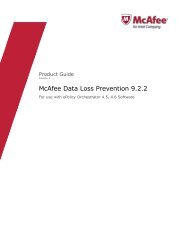Host Intrusion Prevention 7.0.0 for ePO 4.0 Product Guide - McAfee
Host Intrusion Prevention 7.0.0 for ePO 4.0 Product Guide - McAfee
Host Intrusion Prevention 7.0.0 for ePO 4.0 Product Guide - McAfee
You also want an ePaper? Increase the reach of your titles
YUMPU automatically turns print PDFs into web optimized ePapers that Google loves.
Working with <strong>Host</strong> <strong>Intrusion</strong> <strong>Prevention</strong> Clients<br />
Overview of the Windows client<br />
Settings options <strong>for</strong> Firewall logging<br />
As part of troubleshooting you can create firewall activity logs that can be analyzed on the<br />
system or sent to <strong>McAfee</strong> support to help resolve problems. Use this task to to enable Firewall<br />
logging.<br />
Task<br />
1 Select the Firewall Enable Logging checkbox.<br />
2 Select the message type (All or a combination of In<strong>for</strong>mation, Warning, Error, Debug).<br />
3 Click OK. The in<strong>for</strong>mation is written to C:\Documents and Settings\All Users\Application<br />
Data\<strong>McAfee</strong>\<strong>Host</strong> <strong>Intrusion</strong> <strong>Prevention</strong>\FireSvc.log; on Windows Vista: C:\Program<br />
Data\<strong>McAfee</strong>\<strong>Host</strong> <strong>Intrusion</strong> <strong>Prevention</strong>\FireSvc.log folder. After the file reaches 100 MB,<br />
a new file is created.<br />
Disabling <strong>Host</strong> IPS engines<br />
As part of troubleshooting, you can also disable engines that protect a client. <strong>McAfee</strong> recommends<br />
that only administrators communicating with <strong>McAfee</strong> support use this troubleshooting procedure.<br />
For access, click Functionality in the Troubleshooting Options dialog box. In the HIPS<br />
Engines dialog box that appears, disable one or more client system engines by deselecting<br />
the checkbox next to the engine. After the problem has been resolved, and to return to a normal<br />
operating environment, be sure all engines are selected.<br />
Figure 38: HIPS Engines<br />
NOTE:<br />
SQL and HTTP appear in the list only if the client is running a server operating system.<br />
Windows client alerts<br />
A user can encounter several types of alert messages and needs to react to them. These include<br />
intrusion detection, firewall, quarantine, application blocking, and spoof detection alerts. Firewall<br />
and application blocking alerts appear only when the client is in learn mode <strong>for</strong> these features.<br />
Responding to <strong>Intrusion</strong> alerts<br />
If you enable IPS protection and the Display pop-up alert option, this alert automatically<br />
appears when <strong>Host</strong> <strong>Intrusion</strong> <strong>Prevention</strong> detects a potential attack. If the client is in adaptive<br />
90<br />
<strong>McAfee</strong> <strong>Host</strong> <strong>Intrusion</strong> <strong>Prevention</strong> 7.0 <strong>Product</strong> <strong>Guide</strong> <strong>for</strong> use with ePolicy Orchestrator <strong>4.0</strong>

















